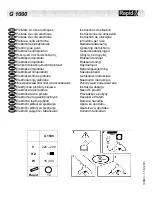
1
gENERAl sAFEty RUlEs
■
For multiple hazards, read and understand the safety
instructions before installing, operating, repairing,
maintaining, changing accessories on, or working
near, the air tool. Failure to do so can result in serious
bodily injury.
■
Only qualified and trained operators should install,
adjust or use the air tool.
■
Do not modify this air tool. Modifications can reduce
the effectiveness of safety measures and increase the
risks to the operator.
■
Do not discard the safety instructions; give them to the
operator.
■
Do not use the air tool if it has been damaged.
■
Tools shall be inspected periodically to verify that the
ratings and markings required by this part of EN 792-
13 are legibly marked on the tool. The employer/user
shall contact the manufacturer to obtain replacement
marking labels when necessary.
pROjECtIlE hAzARds
■
Be aware that the failure of the work piece, or
accessories, or even of the fastener driving tool itself,
can generate high-velocity projectiles.
■
Always wear impact-resistant eye protection during
the operation of the air tool. The grade of protection
required should be assessed for each use.
■
Ensure that the work piece is securely fixed.
ENtANglEMENt hAzARds
Choking, scalping and/or lacerations can occur if loose
clothing, personal jewellery, neck wear, hair or gloves are
not kept away from the tool and accessories.
OpERAtINg hAzARds
■
Operators and maintenance personnel shall be
physically able to handle the bulk, weight and power
of the tool.
■
Hold the tool correctly; be ready to counteract normal
or sudden movements and have both hands available.
■
Maintain a balanced body position and secure footing.
■
Release the start-and-stop device in the case of an
interruption of the compressed air supply.
■
Use only lubricants recommended by the manufacturer.
■
Personal protective safety glasses shall be used; suitable
gloves and protective clothing are recommended.
REpEtItIVE MOtIONs hAzARds
■
When using an air tool to perform work-related
activities, the operator can experience discomfort in
the hands, arms, shoulders, neck or other parts of the
body.
■
While using an air tool, the operator should adopt a
comfortable posture while maintaining a secure footing
and avoiding awkward or off-balanced postures. The
operator should change posture during extended
tasks, which can help avoid discomfort and fatigue.
■
If the operator experiences symptoms, such as
persistent or recurring discomfort, pain, throbbing,
aching, tingling, numbness, burning sensations or
stiffness, these warning signs should not be ignored.
The operator should tell the employer and consult a
qualified health professional.
ACCEssORy hAzARds
■
Disconnect the air tool from the compressed air line
before fitting or changing the fasteners or accessory.
■
Use only sizes and types of accessories and
consumables that are recommended by the air tool
manufacturer; do not use other types or sizes of
accessories and consumables.
WORkplACE hAzARds
■
Slips, trips and falls are major causes of workplace
injury. Be aware of slippery surfaces caused by the
use of the tool and also of trip hazards caused by the
air line.
■
Proceed with care in unfamiliar surroundings. There
can be hidden hazards, such as electricity or other
utility lines.
■
The air tool is not intended for use in potentially
explosive atmospheres and is not insulated against
coming into contact with electric power.
■
Ensure that there are no electrical cables, gas pipes,
etc., that can cause a hazard if damaged by use of
the tool.
NOIsE EMIssION
The characteristic noise values for the fastener driving tool
have been determined in accordance with EN12549:1999
and EN ISO4871 "Acoustics-Noise test code for fastener
driving tools-Engineering method" (see Specifications).
These values are tool-related characteristic values and do
not represent the noise development at the point of use.
Noise development at the point of use will for example
depend on the working environment, the work piece, the
work piece support, the number of driving operations, etc.
Depending in the conditions at the workplace and the form
of the workplace, individual noise attenuation measures
may need to be carried out, such as placing work pieces
on sound-damping supports, preventing work piece
vibration by means of clamping or covering, adjusting
to the minimum air pressure required for the operation
involved, etc.
In special cases it is necessary to wear hearing protection
equipment.

































